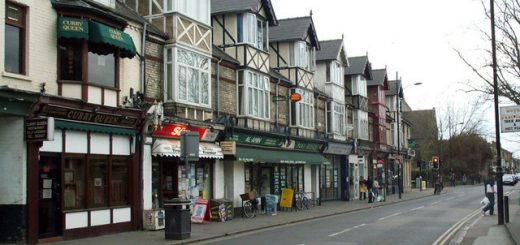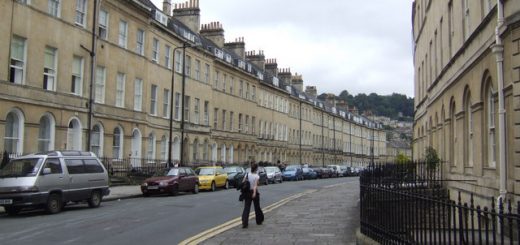All Saints Church, Bristol
All Saints Church is a Grade II listed building with parts dating back to 12th century. Before the dissolution, All Saints was associated with the society of the Kalendaries, who built a public library here. According to ‘The History of Bristol, Civil and Ecclesiastical, Volume 2 (1816)’ by John Corry and John Evans, ‘By far the most interesting part of the establishment of the Kalendaries was their library which was accessible to all the citizens. The liberality indeed of its regulations in this particular entitles it to the highest commendation and is deserving of a more general imitation in similar establishments. It was ordered that on festival days two hours before nine and for two hours after, free access should be granted to all who were disposed to read or to consult the books contained in the library and the prior was directed to attend for that purpose as well as to explain such difiiculties as might occur to those who came for the sake of instruction. The situation of the library was over the north aisle of the church of All Saints towards Corn street, but by the several repairs and alterations which the church has undergone is now entirely removed. The books which the library contained are represented to have related principally to Saxon antiquities ,history and law and to have amounted to eight hundred. The library was unfortunately destroyed by a fire in 1466 by which many very valuable manuscripts were lost and with them many of the records and archives of Bristol.’
![Unknown (initials JW and WW), dated c.1838, Image from the collections of Bristol Record Office [Public domain or CC BY-SA 3.0 (https://creativecommons.org/licenses/by-sa/3.0)], via Wikimedia Commons](http://www.mysteriousbritain.co.uk/wp/wp-content/uploads/2008/08/All_Saints_Church_Bristol_BRO_Picbox-4-BCh-1_1250x1250-157x300.jpg) There is also a story of a haunting associated with All Saints. The following extract describing this is taken from ‘Haunted Churches (1939)’ by Elliott O’Donnell (27 February 1872 – 8 May 1965) ‘In 1846 rumours of strange happenings in a vicarage and an adjoining church were current in Bristol. The vicarage, up to the time of the dissolution of the Calendars, their residence, adjoined and almost formed a part of All Saints church, Bristol. Living in the vicarage were the Rev. and Mrs. Jones, the sexton and sextoness of All Saints, one or two lodgers, and two servants, namely, a maid and cook. The phenomena, which were both auditory and visual, did not, apparently, begin to occur till about the beginning of the aforesaid year. The occupants of the house, particularly Mr. and Mrs. Jones, were then aroused every night by heavy footsteps walking about the house. Sometimes the footsteps would enter their bedroom, and Mr. Jones declared he saw, on several occasions, a ghostly light nickering on the wall. But it was the maid who appears to have had the most harrowing experiences, for not only did she hear the footsteps creaking their way up the staircase and along the passage leading to her room, but she repeatedly heard a bolt, which was on the inside of the door, slyly slid back and someone enter the room. She could neither scream nor bury her head under the bedclothes, but was apparently constrained by an all-compelling power to look.
There is also a story of a haunting associated with All Saints. The following extract describing this is taken from ‘Haunted Churches (1939)’ by Elliott O’Donnell (27 February 1872 – 8 May 1965) ‘In 1846 rumours of strange happenings in a vicarage and an adjoining church were current in Bristol. The vicarage, up to the time of the dissolution of the Calendars, their residence, adjoined and almost formed a part of All Saints church, Bristol. Living in the vicarage were the Rev. and Mrs. Jones, the sexton and sextoness of All Saints, one or two lodgers, and two servants, namely, a maid and cook. The phenomena, which were both auditory and visual, did not, apparently, begin to occur till about the beginning of the aforesaid year. The occupants of the house, particularly Mr. and Mrs. Jones, were then aroused every night by heavy footsteps walking about the house. Sometimes the footsteps would enter their bedroom, and Mr. Jones declared he saw, on several occasions, a ghostly light nickering on the wall. But it was the maid who appears to have had the most harrowing experiences, for not only did she hear the footsteps creaking their way up the staircase and along the passage leading to her room, but she repeatedly heard a bolt, which was on the inside of the door, slyly slid back and someone enter the room. She could neither scream nor bury her head under the bedclothes, but was apparently constrained by an all-compelling power to look.
![NotFromUtrecht [CC BY-SA 3.0 (https://creativecommons.org/licenses/by-sa/3.0) or GFDL (http://www.gnu.org/copyleft/fdl.html)], from Wikimedia Commons](http://www.mysteriousbritain.co.uk/wp/wp-content/uploads/2008/08/402px-All_Saints_Church_Bristol_south_side-201x300.jpg) What she saw was a figure resembling a man with whiskers, clad in a fashion “lang syne gane,” that corresponded, in some measure, with the costume of the Calendars, the former ancient inhabitants of the building.
What she saw was a figure resembling a man with whiskers, clad in a fashion “lang syne gane,” that corresponded, in some measure, with the costume of the Calendars, the former ancient inhabitants of the building.
Sometimes the phantom would approach the bed and shake it, an act which, seemingly, broke the spell gripping the maid, for she was then always able to dive under the clothes and lie quaking there till the ghost had left the room. It was reported that certain of the phenomena, namely, the footsteps and ghostly light, had been experienced in the adjoining church as well, to the terror of the congregation.
Mrs. Crowe, on hearing of these constant strange happenings, was so interested that she wrote about them to the editor of The Bristol Times, who informed her “that the whole affair remained wrapped in the same mystery as when chronicled in the pages of his paper.”
The haunting would seem to have continued nightly for some considerable time and then to have abruptly ceased. ‘




Re: All Saints Church, Bristol
In 1846 the Bristol Times published the following story entitled ‘A Ghost at Bristol’ which concentrated on the vicarage of the Grade II listed All Saints Church, parts of which date back to the 12th Century.
"We have this week a ghost story to relate. Yes, a real ghost story, and a ghost story without, as yet, any clue to its elucidation. After the dissolution of the Calendars, their ancient residence, adjoining and almost forming a part of All Saints’ Church, Bristol, was converted into a vicarage-house, and it is still called by that name, though the incumbents have for many years ceased to reside there. The present occupants are Mr. and Mrs. Jones, the sexton and sextoness of the church, and one or two lodgers; and it is to the former and their servant-maid that the strange visitor has made his appearance, causing such terror by his nightly calls, that all three have determined upon quitting the premises, if indeed they have not already carried their resolution into effect. Mr. and Mrs. Jones’s description of the disturbance as given to the landlord, on whom they called in great consternation, is as distinct as any ghost story could be. The nocturnal visitor is heard walking about the house when the inhabitants are in bed ; and Mr. Jones, who is a man of by no means nervous constitution, declares he has several times seen a light flickering on one of the walls. Mrs. Jones is equally certain that she has heard a man with creaking shoes walking in the bedroom above her own, when no man was on the premises, and ‘was nearly killed with the fright.’ To the servant-maid, however, was vouchsafed the unenvied honour of seeing this restless night visitor; she declares she has repeatedly had her bedroom door unbolted at night, between the hours of twelve and two o’clock the period when such beings usually make their promenades by something in human semblance. She cannot particularise his dress, but describes it as something antique, and of a fashion ‘lang syne gane,’ and to some extent corresponding to that of the ancient Calendars, the former inhabitants of the house. She further says, he is ‘a whiskered gentleman’, which whiskered gentleman has gone the length of shaking her bed, and, she believes, would have shaken herself also, but that she invariably puts her head under the clothes when she sees him approach. Mrs. Jones declares she believes in the appearance of the whiskered gentleman, and she had made up her mind the night before she called on her landlord to leap out of the window (and it is not a trifle that will make people leap out of the windows) as soon as he entered the room. The effect of the flickering light on Mr. Jones was quite terrific, causing excessive trembling, and the complete doubling up of his whole body into a round ball, like."